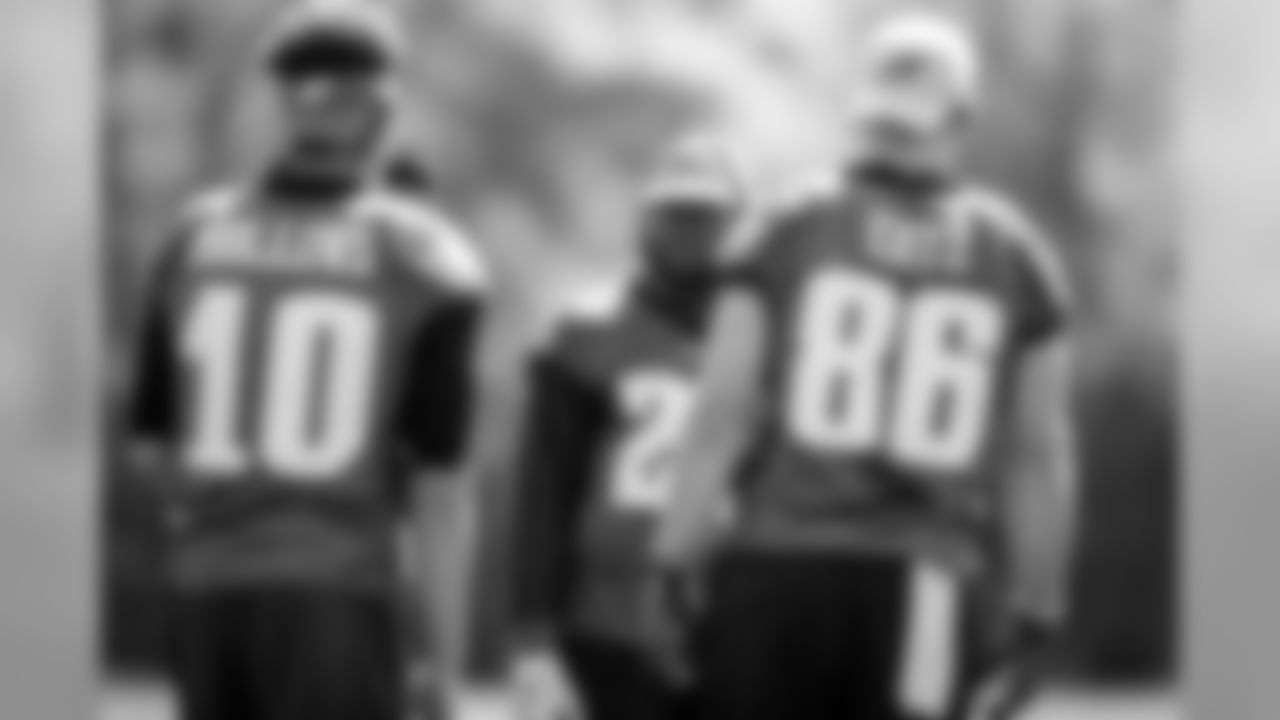Get a glimpse of the Eagles' OTA workouts from the second week of Phase 2.

QB Carson Wentz chats with a few of his receivers.

The Eagles defense huddles up.

RB Jay Ajayi alongside WR Mack Hollins and TE Zach Ertz.

RB Darren Sproles.

S Rodney McLeod.

LB Jordan Hicks.

QB Nick Foles.

WR Nelson Agholor.

LB Nigel Bradham.

RB Corey Clement.

TE Richard Rodgers.

DE Steven Means.

DT Destiny Vaeao.

LB Nathan Gerry.

RB Donnel Pumphrey.

WR Bryce Treggs.

LB Kamu Grugier-Hill.

DE Steven Means.

WR Shelton Gibson.

LB Corey Nelson.

RB Darren Sproles.

CB Sidney Jones.

S Tre Sullivan.

QB Nate Sudfeld.

WR Rashard Davis.
The Eagles signed running back Matt Jones to a contract on Wednesday, adding him to a very talented offensive backfield and, long story short, taking a flier on a player who has had a startling fall from grace in his career. Will a new home and a new offense breathe life into Jones' career, which has been in a downward direction since 2016? The point of this story is not to speculate on Jones' chances with the Eagles; his performance in the weeks and months to come will dictate that. Instead, the focus is on Jones and what has happened to what once was a very promising career.
Washington selected the 6-2, 239-pound Jones in the third round of the 2015 NFL Draft after he gained 817 yards and scored six touchdowns in his junior season at the University of Florida. Jones was not seen then as a "franchise" running back. Instead, he was projected as a power back, a "thunder" complement in an NFL backfield. Said NFL Network analyst Mike Mayock of Jones as he entered the draft: "That is a big specimen right there. Jones is a big, physical downhill guy who needs to learn patience, but he has a lot of talent."
Very quickly, Jones offered a taste of what he could be. In his second NFL game for the Redskins, Jones punished the St. Louis Rams for 123 yards and two touchdowns, including a 39-yard touchdown.
"Big, strong, fast men like that are hard to find," Washington head coach Jay Gruden said of Jones. "That's why we're very lucky to get him when we got him. He does have a rare combination of size and speed and he's got good vision right now. We've just got to keep him going, keep him fresh."
Jones was otherwise up and down as a rookie, finishing with 490 rushing yards, a 3.4-yard-per-carry average, and a big problem with ball security: He coughed up the football five times, turning it over four times.
Despite the uneven performance, Jones was expected to be the lead back for Washington in 2016. The Redskins let Alfred Morris leave in free agency, and Gruden lauded Jones ahead of Year 2.
"Matt played well and we're very excited about him," Gruden said in March 2016. "We let a heck of a running back, and a very productive running back, go because we have Matt. We need him to protect the ball a little bit more. He's a big, strong, powerful back that I think can handle the workload; time will tell on that. We're taking a bit of a gamble here, but based on our professional opinion, we believe he can handle it and be very, very effective at it, toting the rock."
Will Jones be the No. 1 running back, Gruden was asked.
"That's what we envision, yes. He's got the size. I mean, he's got the measurables, that's for sure. That doesn't always translate, so we'll see," Gruden said. "We like Matt. We think he's a smart football player and he runs very, very hard. Now we just have to make sure the ball security is there (because) he can catch the ball out the backfield. He's a very good, solid football player that we have high hopes for."
Those high hopes didn't last for long. Jones was the No. 1 back for Washington early in the 2016 season and he had some shining moments – 61 yards and a touchdown on 13 carries in Week 2 against Dallas, 22 carries, 117 yards and a score against Cleveland two weeks later, and then a couple of weeks after that Jones blistered the Eagles for 16 carries, 135 yards, including a 57-yard gain, and a score in a 27-20 win at Lincoln Financial Field.
The next week, in a game against Detroit, Jones gained just 27 yards on 10 carries and lost a fumble – his third fumble, and second giveaway of the season – and then didn't touch the football the rest of the season. Nine games. Zero carries.
No longer was Jones Washington's No. 1 running back option.
By the time the following summer rolled around, Jones was fifth on Washington's depth chart. He did not attend the team's voluntary workouts and was released prior to the final cutdown to 53 players for the 2017 season.
Jones was then claimed off of waivers by Indianapolis, released a week later, added to the active roster during the season and, all in all, carried five times for 14 yards for a terrible Colts offense and running game. Still, Jones kept his hopes high as he rode the bench.
"I've gotten way better," Jones told reporters late in the 2017 season. "I don't think I'd have gotten this much better if I was playing. I've had time to really step back and watch myself and really learn and improve. I've been watching a lot of other guys, too, a lot of other backs around the league. I've definitely gotten better.
"I've learned a lot about blitzes and run schemes – everything. I thought I knew a lot, but there's so much more to learn. This whole year has made me hungrier. And it's not just that hunger like, 'Oh, I want to play.' It's a different kind of hunger. I'm just waiting on my time."
As recently as March, at the NFL Scouting Combine, the Colts spoke highly of Jones.
"We kept Matt Jones around for a reason. We think Matt Jones has got potential, and we thought really at the end of the year during practice, Matt Jones was coming on really well," said general manager Chris Ballard.
On May 1, the Colts cut Matt Jones after selecting two in the NFL Draft.
Now he's an Eagle in a backfield with Jay Ajayi, Corey Clement, Darren Sproles, Wendell Smallwood, and Donnel Pumphrey. At 239, Jones offers more "thunder" than the other Eagles running backs, but that doesn't mean he's going to make the team. He's going to have to earn every bit of time on the practice field in what's going to be an extremely competitive spring and summer situation.
Signing Jones really isn't any different than what the Eagles have done when they signed, for example, quarterback Joe Callahan. Both have challenging paths to make the roster of the defending Super Bowl champions. But in the case of Jones, what's notable is the direction his career has taken in the last few years and the lesson to be learned: Nothing is given to you in the NFL and nothing is to be taken for granted.














